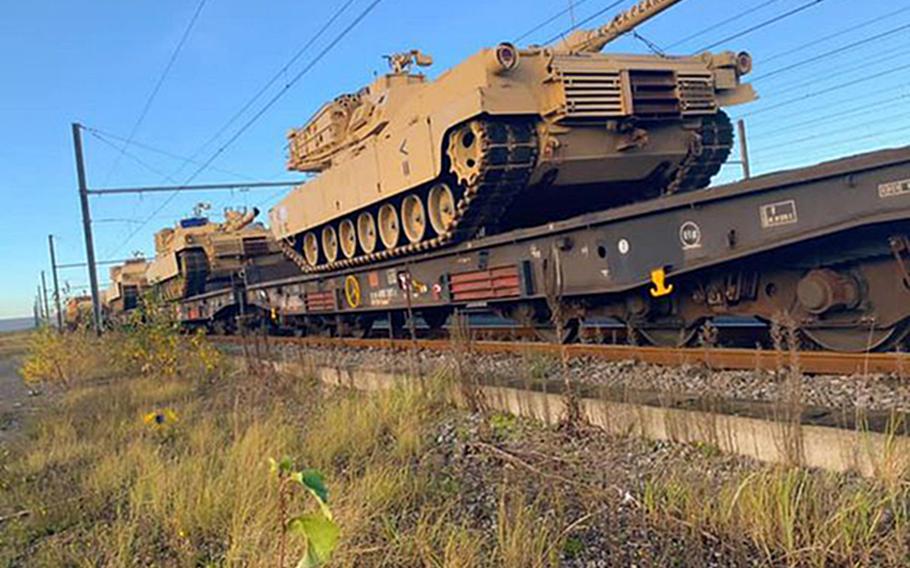
Tanks of the 1st Armored Brigade Combat Team, 1st Cavalry Division, from Fort Hood, Texas are loaded on railway cars in this photo taken from the unit's official Facebook page. The brigade formally takes over the Atlantic Resolve mission on Nov. 30, 2020, when it replaces the 2nd Armored Brigade Combat Team, 3rd Infantry Division as the Army's rotational tank brigade in Europe. (U.S. Army)
STUTTGART, Germany — A Fort Hood, Texas-based armored brigade that just arrived in Europe for a nine-month rotation is bringing with it a new electronic warfare platoon that Army officials say strengthens NATO’s eastern flank.
“We love to fight in the information space,” said Col. Michael Schoenfeldt, who commands the 1st Armored Brigade Combat Team, 1st Cavalry Division.
The “Ironhorse Brigade” formally takes over the Atlantic Resolve mission, focused on deterring Russia, on Monday when it replaces the 2nd Armored Brigade Combat Team, 3rd Infantry Division as the Army’s rotational tank brigade in Europe.
The arrival of the nearly 5,000 Fort Hood soldiers, who will carry out training missions stretching from the Baltics and Poland in the north to the Black Sea region in the south, marks the seventh time the Army has rotated a heavy brigade into Europe. The initiative was launched after Russia’s 2014 intervention in Ukraine, which made reinforcing NATO’s eastern flank a top priority for allies.
New for this deployment is the “Wild Bill” platoon, which the brigade founded to gain the advantage in electronic warfare.
Even when on the move, the unit can see whenever an adversary emits a signal from a cell phone, smart watch or other wireless device, Schoenfeldt said in a phone interview. The unit can then direct strikes at the target if needed.
At Fort Hood, the Wild Bill platoon tested a capability designed to serve as the command’s eyes and ears in the electronic realm. The platoon also can carry out fire missions in a Bradley Fighting Vehicle, which differentiates it from some other electronic warfare platoons.
“The fires section makes Wild Bill a true fire-and-maneuver element rather than a simple collection asset,” Schoenfeldt wrote in the Fall 2020 edition of the Army’s infantry magazine, which detailed how the platoon operates.
The platoon can see nearly any high and ultra-high frequency range, and seek out emitters at 6 miles away or further, Schoenfeldt said.
The new platoon formation is an example of how units are making changes as they organize to counter more sophisticated potential adversaries like Russia.
Protecting communications networks and exploiting those of an adversary is crucial for ground units, which rely on networks to carry out missions. Real-time actionable intelligence “will determine the difference between victory and defeat,” Schoenfeldt wrote in the Army magazine.
For the Army, the importance of electronic warfare faded after the Cold War, but it became more of a priority during the war in Iraq as the Army put in place “dukes” systems to jam insurgent signals to roadside bombs. It’s remained important in the years since, amid concerns that more adversaries and nonstate actors are becoming skilled in electromagnetic attacks.
Much of Schoenfeldt’s brigade is in Grafenwoehr, Germany, where they are under a restriction of movement before they fan out to Poland and elsewhere. The coronavirus has forced extra health precautions on the unit, but training still continues, Schoenfeldt said.
vandiver.john@stripes.com Twitter: @john_vandiver